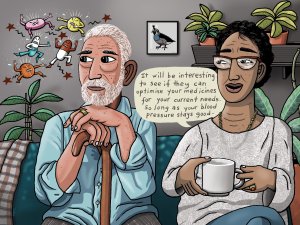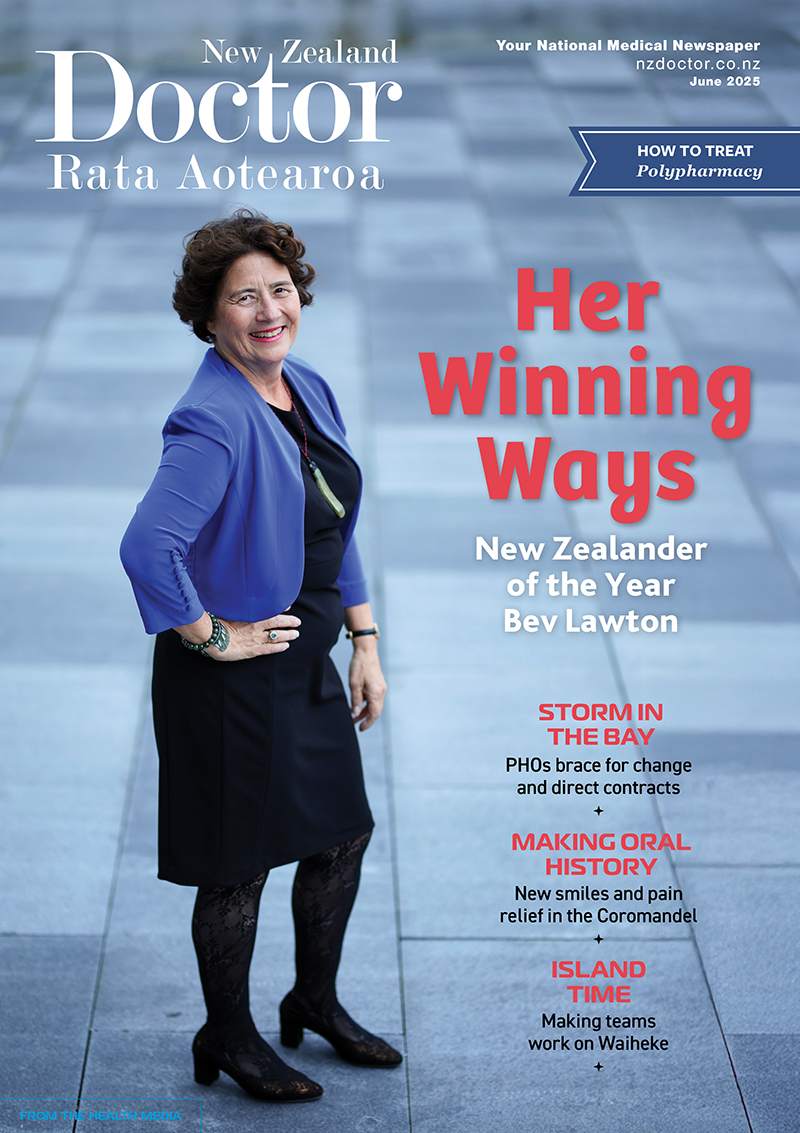For older people and frail people, the long-term benefit of medicines reduces and the potential for harm from adverse effects increases. When the benefit–risk balance changes in this way, medicine review and optimisation are important to simplify the therapeutic regimen, reduce inappropriate medicines and minimise risks. In this article, pharmacist prescriber Linda Bryant uses two case studies to illustrate important considerations during medicine reviews
Not what the doctor ordered
Not what the doctor ordered

When regulation, health and tourism ministers teamed up, the result was a surprising prescription: more medical advertising to drive visitor spending. Side effects may include raised eyebrows, writes Barbara Fountain
A regulation minister, a health minister and a tourism minister walked into a bar. You might have heard this story before, I wrote about it. But it is worth revisiting because it is a sort of bizarre oasis in a maelstrom of unfinished business.
As I write, I am surrounded by unfinished business. While blessed with an abundance of topics due to recent health sector activity, that blessing is as much a curse because, for every announcement made, the unanswered questions form a sort of water torture, drip, drip, dripping on the cranium. What, when, why, who, how and how much? They are the not-so-magic ingredients of a news story. Simple in design but complex in execution. Getting those details is our daily graft, and it can be spectacularly difficult to drill down beneath the political good talk to the actual nub of what’s happening.
By the time you read this, the details of the pre-Budget announcement of $164 million for urgent and after-hours care may have been teased out of the health officials.
been teased out of the health officials. How will these new services be staffed? Why do some areas not get funded facilities? Are the rural and unplanned care and urgent care reviews physical volumes or just a series of PowerPoint slides?
I expect we will still be nutting over other funding elements post-Budget, though expectations of any significant health spending have been dampened down over previous months. Still, Budget 2025 might, or might not, indicate the direction of travel for direct contracting in primary care – maybe a pilot or two or even the whole shebang, or not. In turn, that might mean some clues as to the future capitation formula (still haunted by the ghost of Sapere past) or even the long-languishing mystery “meso” report now being ministered to by the Ministry of Health.
I sense entropy in my thoughts and a lack of fervour in my fingers as they flag across the keyboard. It’s time to revisit that oasis where the worlds of regulation, health and tourism combined to produce one of the wackiest initiatives I have come across, though, you never know, it just might work! When regulation minister David Seymour, health minister Simeon Brown and tourism and hospitality minister Louise Upston went hunting for synergies, they hit a rich vein with a promise of millions in associated revenue over a vague time frame.
The big idea? Remove the regulations that prohibit trade show advertising of medicines that are not approved by Medsafe.
Why? Because it seems New Zealand clinicians are incapable of reading overseas literature and would rather not have to travel abroad when they can stay at home and be subjected to advertising about unapproved medicines to “give them the knowledge and skills to prescribe these treatments safely to Kiwis who need them”. Really? No, that was the media release talking. Elsewhere, it elucidates – cutting the red tape while maybe creating some sector agitation for unapproved medicines. “Workers want to work with top class treatments, and patients want to access them” is about attracting overseas conferences, their delegates and their dollars to New Zealand to generate an estimated $90 million over the “next few years”. That $90 million is partly based on a calculation that “business event participants” spend an average of $175 more per day than other visitors. Who knew that not being able to advertise medicines neither approved for use in New Zealand nor funded was creating such a handbrake for our tourism industry?
This policy change feels like the result of a team-building exercise – go pick someone in the room you wouldn’t usually work with. There is an element of plucky but, ultimately, ramping up advertising of unapproved medicines to gain a tourism bonus is not what the doctor called for. What is needed is a strategy for primary care and the wider health sector that gives a vision for what might be. This continual dribble of promises and policy is steadily eroding all good faith.
TELL US WHAT YOU THINK
Send a Letter to the Editor to editor@nzdoctor.co.nz







![New Zealand Doctor Rata Aotearoa editor Barbara Fountain, RNZCGP president elect and Tauranga-based specialist GP Luke Bradford, Ministry of Health clinical chief advisor rural health Helen MacGregor, and Health New Zealand Te Whatu Ora clinical director primary and community care Sarah Clarke [Image: NZD]](/sites/default/files/styles/thumbnail_cropped_100/public/2025-05/1.%20Barbara%20Fountain%2C%20Luke%20Bradford%2C%20Helen%20MacGregor%20and%20Sarah%20Clarke.jpg?itok=091NETXI)
![Ngāti Porou Oranga specialist GP Elina Pekansaari and Te Nikau Hospital specialist in general practice and rural hospital medicine David Short [Image: NZD]](/sites/default/files/styles/thumbnail_cropped_100/public/2025-05/2.%20Elina%20Pekansaari%20and%20David%20Short.jpg?itok=h5XfSBVM)
![Locum specialist GP Margriet Dijkstra and OmniHealth regional operations manager (southern) Patricia Morais-Ross [Image: NZD]](/sites/default/files/styles/thumbnail_cropped_100/public/2025-05/3.%20Margriet%20Dijkstra%20and%20Patricia%20Morais-Ross.jpg?itok=jkrtRfJC)
![Golden Bay dairy farmer and dairy industry health and safety doctoral student Deborah Rhodes, and Golden Bay Community Health specialist GP Rachael Cowie [Image: NZD]](/sites/default/files/styles/thumbnail_cropped_100/public/2025-05/4.%20Deborah%20Rhodes%20and%20Rachael%20Cowie.jpg?itok=oM0_GcJc)
![Hauora Taiwhenua clinical director rural health Jeremy Webber, Australian College of Rural and Remote Medicine president Rod Martin and Observa Care director of business operations Deborah Martin, the wife of Dr Martin [Image: NZD]](/sites/default/files/styles/thumbnail_cropped_100/public/2025-05/5.%20Jeremy%20Webber%2C%20Rod%20Martin%20and%20Deborah%20Martin%2C%20the%20wife%20of%20Dr%20Martin.jpg?itok=P_aGmX_H)
![Spark Health chief executive John Macaskill-Smith and client director Bryan Bunz [Image: NZD]](/sites/default/files/styles/thumbnail_cropped_100/public/2025-05/6.%20John%20Macaskill-Smith%20and%20Bryan%20Bunz.jpg?itok=5yJvVZ0I)
![Associate dean (rural) Kyle Eggleton, third-year medical student Roselle Winter, and second-year pharmacy student Alina Khanal, all from the University of Auckland [Image: NZD]](/sites/default/files/styles/thumbnail_cropped_100/public/2025-05/7.%20Kyle%20Eggleton%2C%20Roselle%20Winter%20and%20Alina%20Khanal.jpg?itok=RQLd3TEs)
![Health New Zealand Te Whatu Ora clinical editor and specialist in general practice and rural hospital medicine Anu Shinnamon, and Whakarongorau chief clinical officer Ruth Large [Image: NZD]](/sites/default/files/styles/thumbnail_cropped_100/public/2025-05/8.%20Anu%20Shinnamon%20and%20Ruth%20Large.jpg?itok=i5TMswY9)
![Te Kahu Hauora Practice specialist GP Jane Laver and Ngāti Kahungunu ki Tāmaki-nui-a-Rua chief operations manager Tania Chamberlain [Image: NZD]](/sites/default/files/styles/thumbnail_cropped_100/public/2025-05/9.%20Jane%20Laver%20and%20Tania%20Chamberlain.jpg?itok=jtMklaCZ)